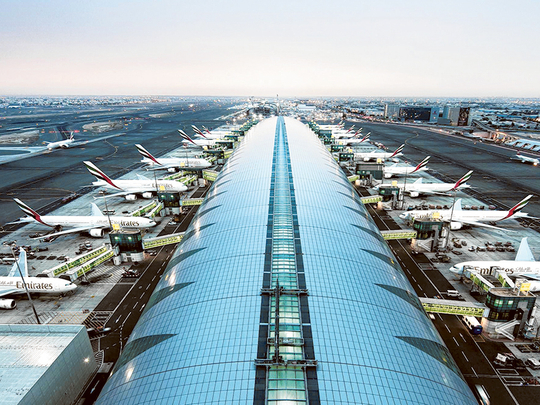
Dubai: Increasing congestion at Dubai International will push airlines into moving over to Dubai’s future mega hub Al Maktoum International, the Chief Executive of operator Dubai Airports said on Monday.
Speaking to Gulf News ahead of Dubai International’s 55th anniversary on September 30, Paul Griffiths said there is already a “push strategy and pull strategy” towards Al Maktoum International in the emirate’s south.
“Dubai International is becoming difficult in the peak hours,” he said by phone.
Dubai International is the world’s busiest airport for international passengers, with more than 70 million seen through its terminals in 2014. Typically, there are around 1,000 flights a day with traffic at its busiest overnight between 10pm and 2am when it operates at 93 per cent of capacity, Griffiths said.
Many airlines still prefer to be at Dubai International because of its proximity to the downtown Dubai area, and because the world’s biggest airline on international routes, Emirates, is not moving over to Al Maktoum International until around 2025. But still, airlines are “seriously considering” moving to the new airport, Griffiths said.
“Some airlines are not able to get the exact slots they want [at Dubai International] … so an alternative is to operate at a less convenient slot or operate at the slot you want at an uncluttered airport to the south,” he said of the “push” factor.
Al Maktoum International at Dubai South, previously Dubai World Central (DWC), only opened its passenger terminal in 2013. Last year, its first full year of passenger operations, Al Maktoum International handled 845,046 passengers but largely due to a temporary runway closure at Dubai International that moved flights over to the secondary airport.
But Al Maktoum International has also developed its own appeal as a separate catchment area. “Some airlines are seeing the attractiveness of Dubai World Central as a destination in its own right ... they love the uncluttered nature the simplicity of the product,” Griffiths said. “We’ve had very good passenger feedback.”
Qatar Airways, Jazeera Airways and Gulf Air fly to the new airport in addition to Dubai International. European low cost airline Wizz Air flies to just two destinations in the Middle East, one being Al Maktoum International.
“It’s actually going to be an airport that serves a growing city incredibly well and you’ll get the north side to DXB (Dubai International) and the south side to DWC.
But while some airlines will move over to the new airport, Griffiths said, others will start to fill up slots in the middle of the day at Dubai International.
“Hours around the peak hours will be the next to fill up,” he said.
Next month, flydubai will launch 70 new weekly flights a week from Al Maktoum International and Lufthansa subsidiary, Eurowings, will start flying to the airport.
Griffiths said it will be a “major milestone” for the airport “when flydubai starts to make DWC its second hub in Dubai.”
But the transition from Dubai International to Al Maktoum International is expected to take at least a decade.
“Of course the big transition will happen we when we have enough capacity to operate DWC as a hub,” Griffiths said.
In September 2014, Dubai Airports announced a $32 billion (Dh117.69 billion) Dubai government-approved expansion of Al Maktoum International that will increase capacity to 120 million passengers a year. Construction of the expansion to turn the airport into a mega hub has not started with Dubai Airports still in the design and tender stage, Griffiths said.
“It’s going to take 10 years to come into fruition but we need the capacity now as we got to get on with it,” he said.
Construction to expand the airport to handle 26 million passengers a year by 2018, announced May 2015, will start in the first quarter of 2016, Griffith said.












